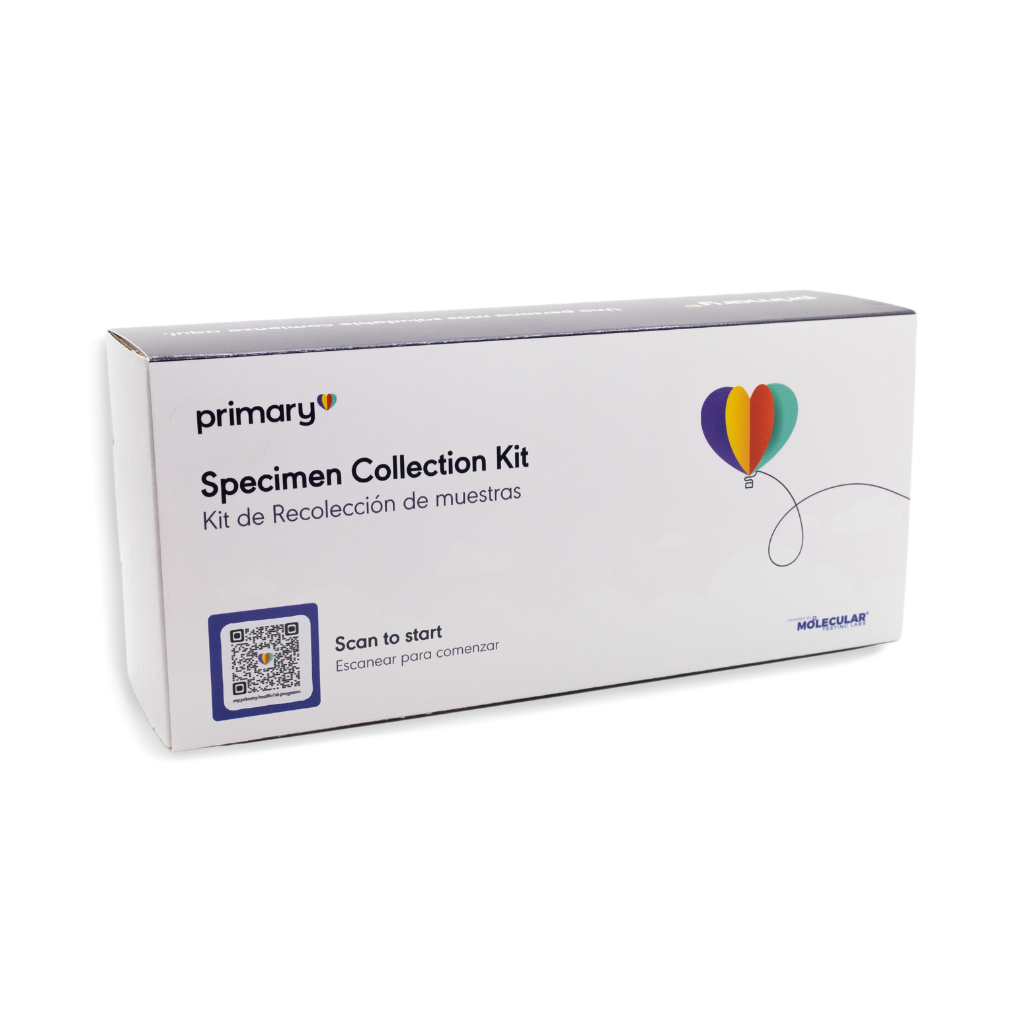Search

About At-home Chlamydia and Gonorrhea Test Kits (3-site CT/GC)
Test for both Chlamydia and Gonorrhea (CT/GC) with a discreet 3-site sample.
This page covers CT/GC FAQs and how-to videos for vaginal, oral, and rectal testing. Send us a note if you are interested in group ordering for your program.
Send us a note to chat about:
Group ordering
Program support
Using the Primary platform to facilitate clinic workflows or lab results
And more
Intended for informational purposes only
Common Questions and Answers
What you can generally expect from ordering test kits
FSA/HSA eligible
At-home 3-site test for urine, oral swab, rectal swab
Discreet packaging delivered to you
Results in under 5 days
Live chat and email support
Free follow-up with a clinician for all positive results
Treatment options
Digital care coordination
Member Login
Reasons to test for Chlamydia and Gonorrhea (CT/GC)
About Chlamydia and Gonorrhea
Chlamydia and gonorrhea are common sexually transmitted diseases (STDs) that are caused by bacteria.
An overgrowth of the bacteria chlamydia trachomatis causes chlamydia, while gonorrhea is caused by an overgrowth of the bacteria neisseria gonorrhoeae.
Some people with chlamydia and gonorrhea may not have symptoms. Others may recognize the telltale symptom of both: a burning sensation when you pee.
Both chlamydia and gonorrhea can be spread through vaginal, anal, or oral sex, even if nobody is having symptoms and nobody ejaculates.
Both STIs may lead to infertility both in men and women or serious health issues to a newborn baby. So if you’re trying or expecting, it’s important to get tested and treated.
The good news is that chlamydia and gonorrhea is preventable and treatable: they’re both effectively treated with antibiotics, and regular testing keeps you and your partner(s) safe.
Why test?
While chlamydia and gonorrhea are easily spread, it is easy to test and treat them both.
- A test for two in three places: Chlamydia and gonorrhea, sexually transmitted diseases that frequently affect people at the same time.
- Test for Chlamydia (CT) and Gonorrhea (GC) in the genitals, throat, or rectum using a Chlamydia and Gonorrhea (CT/GC) test kit.
Chlamydia and gonorrhea test kit
Designed for:
- Anyone sexually active 18 years and older.
Chlamydia and gonnorhea FAQs
Questions and Answers about Chlamydia and Gonnorhea
What is Chlamydia? What about Gonorrhea?
Chlamydia
Chlamydia is a sexually transmitted disease (STD) that can cause an infection in someone’s genitals, rectum, and/or throat. Some people may have no symptoms at all, or symptoms may occur several weeks after sexual contact with someone with chlamydia.
Untreated chlamydia can seriously affect a woman’s reproductive system, leading to pelvic inflammatory disease (PID), which can lead to infertility and ectopic pregnancy. In pregnancy, it may lead to premature delivery, or spread to the newborn during delivery.
In men, untreated chlamydia damages the sperm, leading to the inability to impregnate a partner.
Gonorrhea
Gonorrhea is a sexually transmitted disease (STD) that can affect a person’s genitals, rectum, and/or throat. Like chlamydia, people may not know they have it. In women, symptoms are often mild and might be mistaken for a UTI or vaginal infection.
In both men and women, untreated gonorrhea is more likely to lead to infertility than chlamydia.
Why screen for chlamydia and gonorrhea at the same time?
A person may have chlamydia and gonorrhea separately or at the same time, so it is more effective to test for both at once.
What kind of test does Primary.Health Medical offer to screen for chlamydia and gonorrhea?
Primary.Health Medical offers two test kits to screen for chlamydia and gonorrhea: a single-site urine test and a 3-site test.
This is the 3-site test kit which tests for chlamydia and gonorrhea in the genitals (penis or vagina), mouth, and anus.
Who should use Primary.Health Medical’s Chlamydia and Gonorrhea (CT/GC) 3-site test kit?
Primary.Health Medical’s Chlamydia and Gonorrhea (CT/GC) 3-site test kit is designed for adults 18 years and older who have penetrative (intercourse) and non-penetrative (outercourse) vaginal, penile, anal, and/or oral sex.
How do I collect a sample for the Chlamydia and Gonorrhea (CT/GC) 3-site test kit? Will it hurt?
The Primary.Health Medical Chlamydia and Gonorrhea (CT/GC) 3-site test kit comes with everything you need, including instructions on how to collect a sample and send back your kit. This kit includes a test tube to send a small amount of urine (pee), an rectal swab to collect a rectal sample, and an oral swab to collect a sample from your throat.
Before you take this test, please do not urinate for 1 hour. If you can take this test first thing when you wake up in the morning, that is best.
The rectal swab only needs to be inserted into the anus 1-2 inches, or 3-5 centimeters for about 10 seconds. It may feel uncomfortable to some people.
The tip of the oral swab needs to be rubbed in the back of your throat for 10 seconds. Some people may find this uncomfortable.
Can I take this test while on my period?
Yes, you may collect a urine, oral, or rectal sample to do this test while on your period.
Can I pee before I take this test?
No, please do not urinate for 1 hour (60 minutes) before you take the test.
Do I need to send in a urine, rectal, and oral sample to do this test?
The samples that you send in depend on the types of sex you have and the body parts you use during sex.
If you had genital intercourse (penile-vaginal sex), you just need to send in a urine sample. If you only had this type of sex, you may want to consider ordering our Chlamydia and Gonorrhea (CT/GC) single-site urine test kit instead.
If you had anal sex (receptive anal sex), then please collect a rectal sample, as gonorrhea and chlamydia can affect both the genitals and the rectum.
If you performed oral sex on someone’s genitals or anus, then include an oral sample, since gonorrhea and chlamydia can affect the throat.
If you had all the types of sex listed above, please send in a urine sample, along with a rectal and oral sample.
How often should I get screened for chlamydia and gonorrhea?
In general, everyone sexually active should get screened for chlamydia and gonorrhea once a year.
Both men and women may want to screen more often, depending on how often they have sex and with whom. It is recommended that people with new or multiple partners get screened more often than once a year.
Couples that are trying to become pregnant should ask their provider when to get tested. Pregnant women should also talk to their provider about when to get tested.
What is the test sensitivity for chlamydia and gonorrhea?
The test sensitivity for the chlamydia and gonorrhea urine test is 100%. This means that the test will detect a chlamydia or gonorrhea infection in the genitals 100% of the time.
What are the symptoms of chlamydia and gonorrhea?
Symptoms of chlamydia:
Many people do not show symptoms. If people do have symptoms:
Women may experience:
- Irregular vaginal discharge
- Pain or a burning feeling when urinating
- Bleeding after sex
- Bleeding in between periods
Men may experience:
- Discharge from the penis
- Pain or a burning feeling when urinating
- Testicular pain
Symptoms of gonorrhea:
Many people do not show symptoms. However if symptoms do occur:
Women may experience:
- Irregular vaginal discharge
- Pain when urinating
- Discomfort in the lower stomach
- Bleeding from the vagina after sex or in between periods
Men may experience:
- Pain when urinating
- Pus-like discharge from the penis
- Pain or swelling in one testicle
In men and women who may have oral gonorrhea:
- Throat infections
- Mild sore throat
- Inflammation in the back of the throat
In men and women who may have anal gonorrhea:
- Rectal and anal pain
- Rectal and anal discharge
Can I have both chlamydia and gonorrhea at the same time?
Yes, it is possible to have both chlamydia and gonorrhea at the same time.
Can you treat both chlamydia and gonorrhea at the same time?
Yes, it is possible to treat both chlamydia and gonorrhea at the same time with antibiotics. If you test positive for chlamydia or gonorrhea, or both, our clinical team can recommend proper treatment.
How is chlamydia and gonorrhea transmitted?
Chlamydia and gonorrhea are transmitted through sexual activities. You can get either STD by having vaginal, anal, penile, or oral sex with someone with chlamydia or gonorrhea. Chlamydia may also be transmitted through skin-to-skin contact during sex, or if sperm or vaginal fluid come in contact with someone’s eye during sex.
Chlamydia and gonorrhea may also be transmitted to a newborn during childbirth.
How can I protect myself from chlamydia and gonorrhea?
The best way to protect yourself from chlamydia and gonorrhea is to practice safer sex, get tested, and communicate with your partner(s).
Have more questions? Contact us at support@primary.health
3-sites: Vaginal, oral, and rectal
How to use your Chlamydia and Gonorrhea (CT/GC) 3-site test kit
Site 1 example: Vaginal swab
Site 2 example: Oral swab
Site 3 example: Rectal swab
Clinical Leadership
Aditya Chandrasekhar, MD, MPH, FACP
Medical Director
He is triple board certified (internal medicine, pulmonary medicine, and critical care). He completed his medicine training at Georgetown University while doing his MBA at Johns Hopkins, followed by training in pulmonary/critical care at the Cleveland Clinic. He has published extensively in clinical medicine, health economics, and digital health, and has presented nationally and internationally on the same. Dr. Fadul also serves on the Board of Directors for MedWish International and leads medical missions overseas.
Rafid Fadul, MD, MBA
Primary.Health Medical CEO and Clinical Advisor
Katie Kowals, RN, BSN
Registered Nurse











